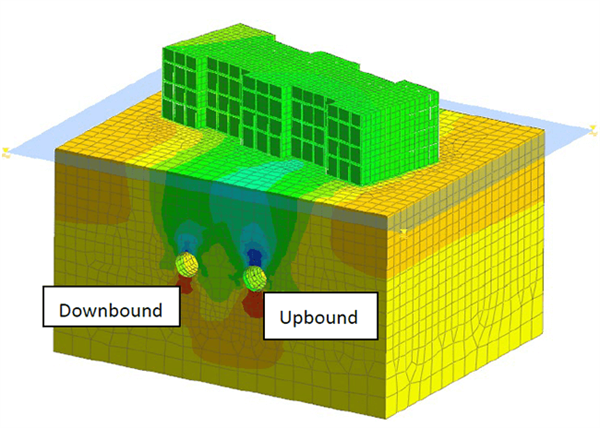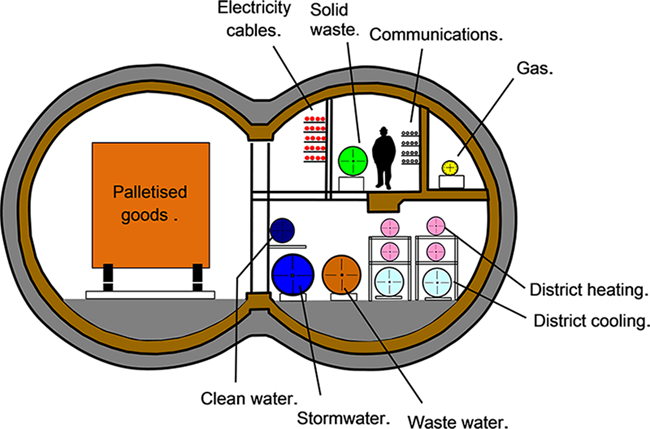As populations grow in dense urban city centres, so too does the demand for space and natural resources. In the UK the competition for underground space in the urban environment is at an all-time-high. The requirement to improve transport links, not least in urban centres (e.g. London and Birmingham), and housing provision has seen and will continue to see ever increasing amounts of tunnel construction and utility placement.
Each new tunnel constructed has the potential to disturb existing underground structures (i.e. utilities, tunnels and foundations) and cause movements and damage in overlying buildings. For these reasons, ground movements need to be modelled both numerically and physically at a range of scales in order that appropriate predictive methods can be developed and mitigation measures put in place. Predicting surface and sub-surface movements above multiple tunnels is a continually evolving field. Our researchers have looked at this and significantly improved our understanding. NBIF allows more extensive and detailed research at a much larger scale than has been considered previously to investigate the impact of tunnel induced ground displacements.

3D FEM modelling of potential building damage caused by twin tunnel construction
Alternative utility placement methods (e.g. MUT’s for utilities) and innovative material choices need to be both identified and tested in order that Net zero, as part of a more, resilient sustainable and carbon free urban environment can be achieved. NBIF enables this full-scale testing to take place, enabling an evidence-based future proofing facility for our infrastructure assets. Any innovation will require an understanding of business models and governance regimes to allow for their seamless integration – this is another key area of research we continue to look into.

A Double Oval Multiple Utility Tunnel (MUT)
Useful papers
- Makana, L.O., Jefferson, I., Hunt, D.V.L. and Rogers C.D.F. (2016) Assessment of the future resilience of sustainable urban sub-surface environments Tunnelling and Underground Space Technology, 55, 8 -20. https://doi:10.1016/j.tust.2015.11.016
- Chapman, D.N., Metje, N., Stark, A. (2018) Introduction to Tunnel Construction. CRC Press. 450 pages.
- Hunt, D. V. L. (2005) Predicting the ground movements above twin tunnels constructed in London Clay, PhD thesis, July 2005, University of Birmingham, UK.
- Chapman, D. N., Ahn, S. K. and Hunt, D. V. L (2007) Investigating ground movement caused by the construction of multiple tunnels in soft ground using laboratory model tests. Canadian Geotechnical Journal, 44 (6), 631-643.
- Hunt, D.V.L, Nash, D. and Rogers, C.D.F (2014). Sustainable utility placement via multi utility tunnels. Tunnelling and Underground Space Technology. 39, 15-26 http://dx.doi.org/10.1016/j.tust.2012.02.001
- Thomas, A.M., Lombardi, D.R., Hunt, D.V.L, and Gaterell, M. (2009) Estimating carbon dioxide emissions for aggregate use, Proceedings of the Institution of Civil Engineers: Engineering Sustainability, 162 (3) 135-144 https://www.icevirtuallibrary.com/doi/epdf/10.1680/ensu.2009.162.3.135
- Shrimpton, E. A., Hunt, D.V.L. and Rogers, CD.F. (2022). A Governance Framework for Implementation of Scientific and Engineering Innovation in Buried Infrastructure Systems. Frontiers in Sustainability (Special Issue Environmental Data, Governance and the Sustainable City) https://doi.org/10.3389/frsc.2022.765577.
- Chapman D.N., Metje, N., Stärk, A. (2017). Introduction to Tunnel Construction. 2nd edition, Taylor & Francis.